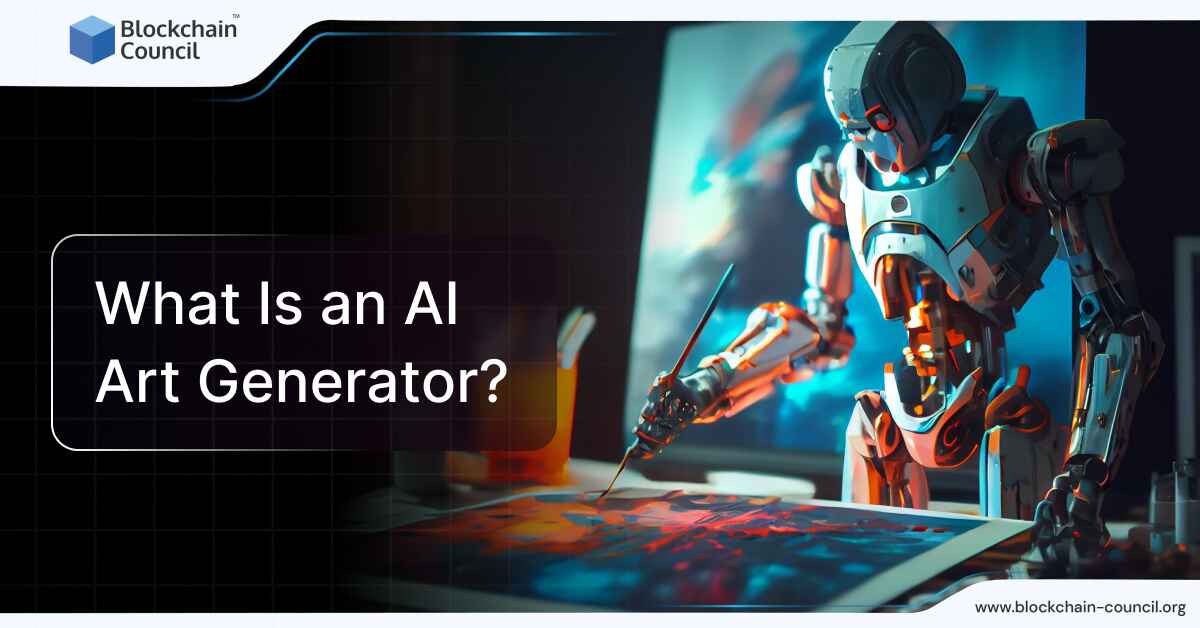
- Blockchain Council
- September 13, 2024
Summary
- AI art generators leverage generative AI to transform text prompts into various styles of digital artwork, catering to both professionals and amateurs in the creative realm.
- These tools democratize art creation by allowing anyone, regardless of skill level, to produce visually stunning pieces from simple text descriptions or existing images.
- Leading AI art generators like NightCafe, Adobe Firefly, and OpenAI’s DALL·E exemplify the transformative impact of AI on the creative landscape.
- The significance of AI art generators extends beyond static images to encompass videos, documents, and digital experiences, fostering creativity while ensuring responsible usage.
- Exhibitions such as “AI: More Than Human” and “Faceless Portraits Transcending Time” underscore AI’s role in pushing creative boundaries and sparking debates on machine authorship.
- Despite AI’s mimetic nature and its limitations in contextual understanding, AI art generators enhance human creativity rather than replacing it, exemplifying augmented intelligence.
- These tools operate through diffusion models or Generative Adversarial Networks (GANs), offering user-friendly interfaces for creating art with just a text prompt.
- Applications of AI art generators range from personal and professional art creation to logo design, music generation, photo editing, and website building.
- Ethical considerations and copyright issues surrounding AI art generators highlight the importance of responsible innovation and adherence to fair use principles.
- In conclusion, AI art generators democratize art creation, merge technology with human creativity, and redefine the boundaries of imagination in the digital age.
In the era of digital creativity, AI art generators are transforming the landscape of visual arts, enabling both professionals and hobbyists to explore new realms of artistic expression. These tools harness the power of artificial intelligence to create stunning images, paintings, and illustrations from simple text prompts or existing images. Whether you’re looking to create pop art, marble sculptures, clay ceramics, or explore unlimited styles, these AI art generators provide the tools to unleash your creativity But what exactly is an AI art generator?
Read till the end to find answers. This article aims to provide a comprehensive overview, ensuring that both novices and professionals grasp the essence of these innovative tools.
Also Read: How Does Character AI Work?
What Is an AI Art Generator?
An AI art generator is an innovative tool that creates digital images using generative AI, transforming text prompts into artwork in various styles, like pop art or watercolor paintings. These tools are accessible to anyone, regardless of their artistic skill level, allowing for quick creation of images from simple text descriptions. These platforms enable users to transform text or images into unique pieces of art through various AI algorithms. Users can input a text prompt or upload an image, and the AI interprets this input to generate art in a multitude of styles and formats.
Significance in Today’s World
- AI Art Generators like NightCafe, Adobe Firefly, and OpenAI’s DALL·E are revolutionizing how we approach creativity and art production. NightCafe Creator, for instance, offers a free online platform that employs neural style transfer and text-to-image AI, allowing users to create art from photos or textual descriptions. This inclusivity and accessibility democratize art creation, making it possible for anyone with an idea to create beautiful artworks without needing traditional artistic skills.
- Adobe’s Firefly extends the potential of generative AI beyond static images, enabling the creation of videos, documents, and digital experiences. It’s built on Adobe’s long history of empowering creators, focusing on commercially safe, copyright-conscious content generation. This approach not only fosters creativity but also ensures responsible use of AI in art.
- DALL·E, developed by OpenAI, showcases remarkable capabilities in adapting images to various styles, angles, and contexts, pushing the boundaries of AI’s creative potential. For example, DALL·E can generate detailed, contextual art based on text prompts, reflecting a sophisticated understanding of visual concepts and their interrelations.
- AI art generators are transforming the creative landscape, offering new opportunities and challenges for artists and designers. Exhibitions like “AI: More Than Human” at the Barbican in London and “Faceless Portraits Transcending Time” in New York showcase the groundbreaking potential of AI in art, highlighting both the enthusiasm and skepticism surrounding this technology. These shows reveal AI’s role in pushing the boundaries of creativity, while also sparking debates on machine authorship and the future of art.
- AI art’s mimetic nature, its ability to imitate and create within the confines of its training data, presents both limitations and possibilities. For instance, while a GAN trained on Van Gogh’s paintings can generate countless variations in his style, it cannot reflect on the art historical context of Van Gogh’s work. This underscores the ongoing discussion about the role of AI in art, questioning whether machines can truly be creative or if they merely act as tools for human expression.
- These AI Art Generators exemplify the concept of “augmented intelligence,” enhancing human creativity rather than replacing it. By automating the repetitive aspects of the creative process, they allow individuals to focus on innovation and expression. The technology behind AI art is rapidly evolving, reflecting a broader trend toward integrating AI into everyday life to enhance productivity and creativity.
Also Read: What is a Chatbot? A Complete Guide
How AI Art Generators Work
AI art generators are powerful tools that turn text prompts into visual art by using computer technology and machine learning. They are trained on vast amounts of image-text pairs, allowing them to understand and generate art based on your requests. There are two main types of models used: diffusion models (like Stable Diffusion and DALL-E 3) and Generative Adversarial Networks (GANs) (such as VQGAN-CLIP and BigGAN). These models either refine a noise field into an image or use a generator and discriminator to create new artworks. The process is complex but user-friendly, allowing anyone to create art with just a text prompt.
Applications of AI Art Generators
- Personal and Professional Art Creation: Generate unique art for personal projects or professional use, such as marketing materials or website visuals.
- AI Logos: AI can design logos for businesses or personal projects, with tools like the Wix Logo Generator offering both AI-generated suggestions and customizable options.
- AI Music Generators: Tools like Mubert allow content creators to generate soundtracks for their projects, offering an easy and fast solution to create music with AI.
- AI Photo Editing: Enhance or modify photos using AI photo enhancers and image upscalers, or create new images from text prompts with tools like Photoshop AI.
- AI Website Builders: For those needing a new website quickly, AI website builders can create entire websites from simple text prompts, simplifying the web design process.
Leading AI Art Generators in the Market
AI Art Generators like Freepik AI Image Generator, NightCafe, Adobe Firefly, and OpenAI’s DALL·E are revolutionizing how we approach creativity and art production. Freepik AI Image Generator can create free high-quality photorealistic AI images using prompts and generates images in real-time and various styles, colors, framing, and lighting. NightCafe Creator, for instance, offers a free online platform that employs neural style transfer and text-to-image AI, allowing users to create art from photos or textual descriptions. This inclusivity and accessibility democratize art creation, making it possible for anyone with an idea to create beautiful artworks without needing traditional artistic skills.
Ethical Considerations and Copyright
The evolution of AI art generators has sparked a lively debate on ethical considerations and copyright issues. These technologies offer new horizons for creativity, enabling users to produce art in ways previously unimaginable. However, they also raise critical questions about the originality of art and the rights of creators.
Ethical Use of Licensed Content
One of the primary concerns revolves around the training data used by AI models. Responsible AI art generator companies are now emphasizing the importance of using copyright-free or properly licensed materials for training their models. This shift aims to respect the copyrights of artists and creators, ensuring that AI-generated art does not infringe upon existing works without permission.
Also Read: What are Agents in Artificial Intelligence (AI)?
Fair Use and Copyright Law
The concept of “fair use” plays a significant role in the debate over AI-generated art. According to the Electronic Frontier Foundation, the process of creating AI art involves steps like scraping images from the web and analyzing them to produce new, non-infringing images. This process is considered fair use, as it does not directly copy or store the original images but rather uses them to generate entirely new works that are not substantially similar to the originals.
Moreover, the information stored by AI models is often not sufficient to recreate the original training images, further distancing AI-generated works from copyright infringement. The legal principle of “de minimis,” meaning too minimal to qualify as infringing, is also highlighted as a defense for AI art generators. The notion here is that the copyrightable expression taken from each image in the training set is too insignificant to be considered an infringement.
Responsible Innovation
As AI art generators continue to evolve, the focus on ethical considerations and copyright respect is paramount. By adhering to principles of fair use and ensuring that AI models are trained on legally sourced material, developers and users of AI art generators can navigate the complex landscape of copyright law while fostering innovation and creativity.
Also Read: What is Gemini AI?
Conclusion
AI art generators represent a significant leap forward in the democratization of art creation, making it accessible to a wider audience regardless of their artistic background. These platforms not only serve as a testament to the incredible potential of artificial intelligence in enhancing creative endeavors but also offer a glimpse into the future of art, where technology and human creativity merge to create new forms of expression. As we continue to explore the capabilities of AI art generators, we are not just witnessing the evolution of art but are actively participating in a creative revolution that is redefining the boundaries of imagination.
Frequently Asked Questions
What is an AI art generator?
- An AI art generator is a tool that utilizes artificial intelligence to create digital images, paintings, and illustrations from text prompts or existing images.
- These generators employ advanced algorithms to interpret input and generate artwork in various styles, such as pop art, watercolor paintings, or marble sculptures.
- They are accessible to users of all skill levels, enabling quick creation of art from simple text descriptions or uploaded images.
- Examples of AI art generators include NightCafe, Adobe Firefly, and OpenAI’s DALL·E.
How do AI art generators work?
- AI art generators use computer technology and machine learning to turn text prompts into visual art.
- They are trained on vast amounts of image-text pairs, allowing them to understand and generate art based on user requests.
- Two main types of models are used: diffusion models (like Stable Diffusion and DALL-E 3) and Generative Adversarial Networks (GANs) (such as VQGAN-CLIP and BigGAN).
- The process involves either refining a noise field into an image or using a generator and discriminator to create new artworks, all through user-friendly interfaces.
What can I use AI art generators for?
- AI art generators have various applications, including personal and professional art creation for projects, marketing materials, or website visuals.
- They can design logos for businesses or personal projects, offering both AI-generated suggestions and customizable options.
- Content creators can generate soundtracks for their projects using AI music generators like Mubert, providing an easy and fast solution for music creation.
- Additionally, AI art generators can be used for photo editing, website building, and creating digital art on mobile platforms, offering diverse opportunities for artistic expression.
Are there any ethical considerations with AI art generators?
- Yes, ethical considerations surrounding AI art generators include issues related to copyright and fair use.
- Responsible AI art generator companies emphasize using copyright-free or properly licensed materials for training their models to respect the rights of creators.
- The concept of fair use plays a significant role in the debate over AI-generated art, with processes like scraping images from the web considered fair use as they produce new, non-infringing works.
- Adherence to ethical principles and copyright laws is essential for developers and users to navigate the complex landscape of AI-generated art while fostering innovation and creativity.

































































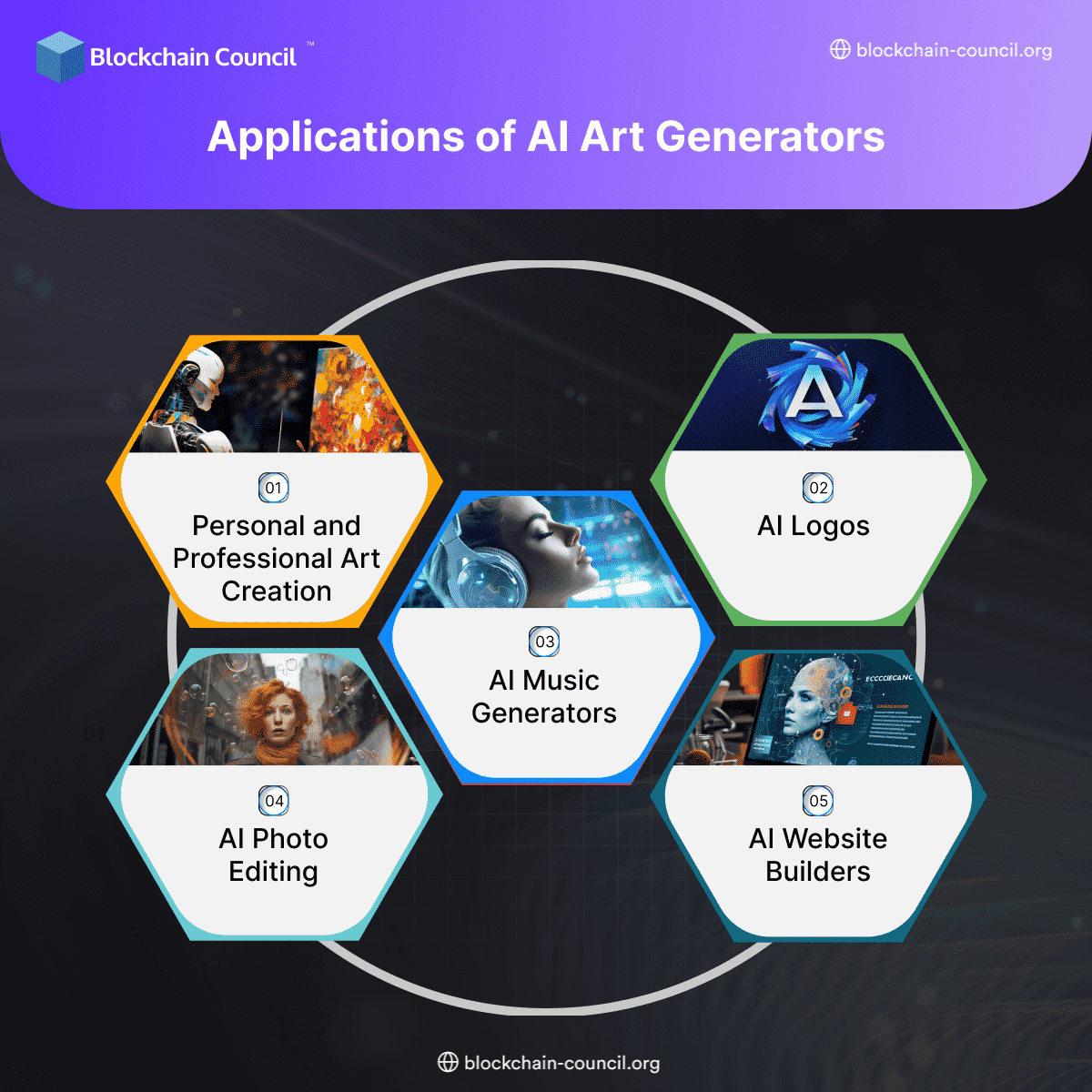
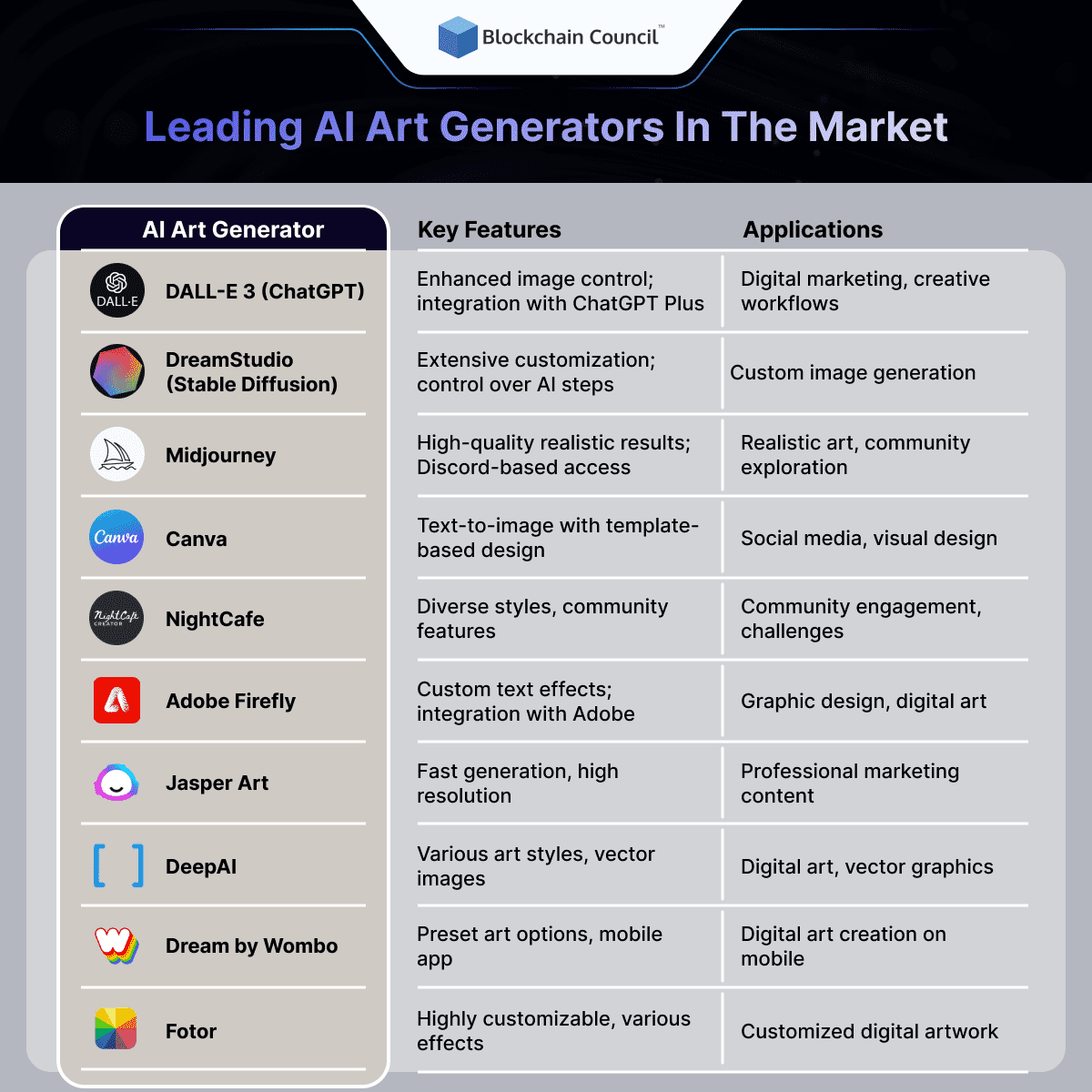

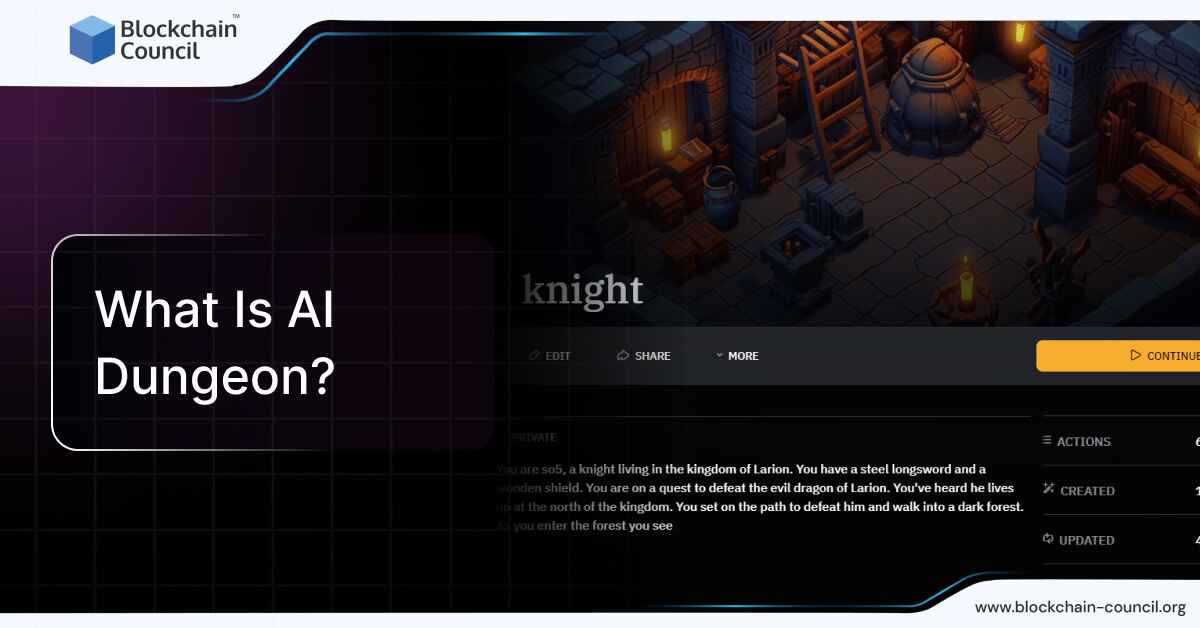

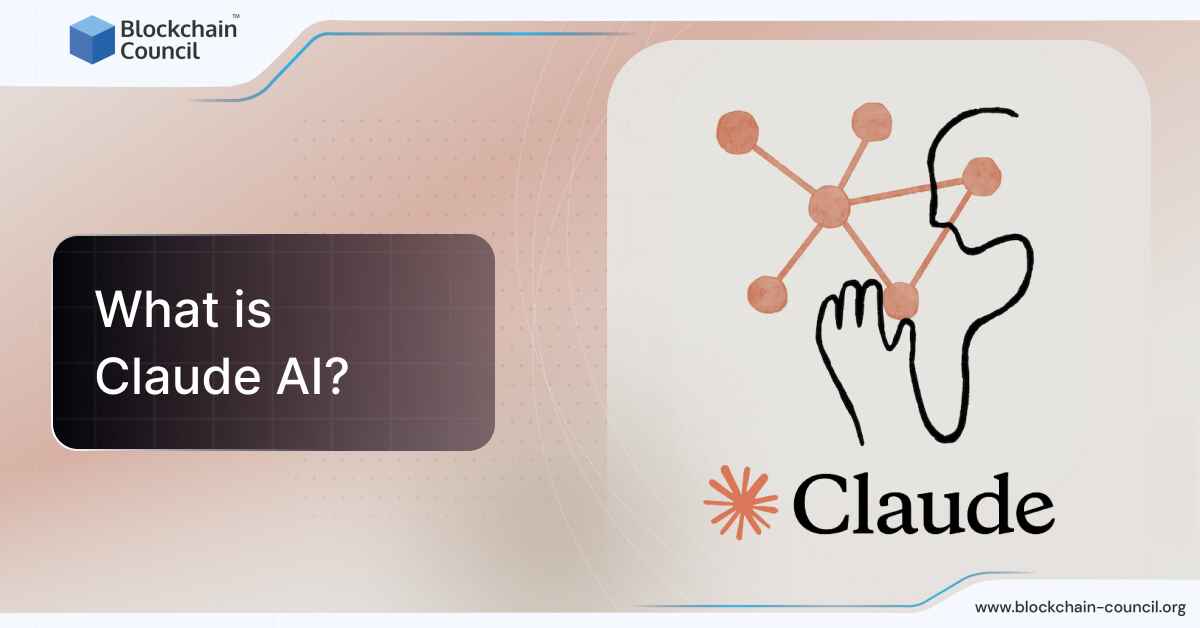
 Guides
Guides News
News Blockchain
Blockchain Cryptocurrency
& Digital Assets
Cryptocurrency
& Digital Assets Web3
Web3 Metaverse & NFTs
Metaverse & NFTs
